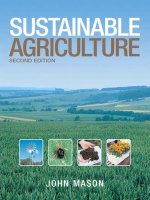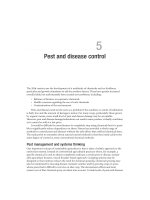SUSTAINABLE AGRICULTURE 2nd Edition - Part 1 docx
Bạn đang xem bản rút gọn của tài liệu. Xem và tải ngay bản đầy đủ của tài liệu tại đây (230.03 KB, 15 trang )
SUSTAINABLE
AGRICULTURE
JOHN MASON
Second Edition
National Library of Australia Cataloguing-in-Publication:
Mason, John, 1951– .
Sustainable agriculture.
2nd ed.
ISBN 0 643 06876 7.
1. Sustainable agriculture. 2. Sustainable development.
I. Title.
338.16
Copyright © John Mason 2003
All rights reserved. Except under the conditions described in the Australian Copyright Act
1968 and subsequent amendments, no part of this publication may be reproduced, stored
in a retrieval system or transmitted in any form or by any means, electronic, mechanical,
photocopying, recording, duplicating or otherwise, without the prior permission of the
copyright owner. Contact Landlinks Press for all permission requests.
Published by and available from:
Landlinks Press
PO Box 1139
Collingwood Vic. 3066
Australia
Te lephone: +61 3 9662 7666
Freecall: 1800 645 051
(Australia only)
Fax: +61 3 9662 7555
Email:
Website: www.landlinks.com
Cover design and text design by James Kelly
Set in 10.5/13 Minion
Printed in Australia by BPA Print Group
Front cover photograph courtesy of John Mason
Acknowledgements v
Introduction 1
1 Different things to different people 3
2Sustainable concepts 9
3 Soils 23
4Water management 49
5 Pest and disease control 77
6Sustainable natural weed control and cultivation 101
7 Management 113
8Managing plants – Crops and pastures 129
9Managing plants – Tree plantings and windbreaks 155
10 Managing animals in a more sustainable way 171
11 Understanding products used in sustainable agriculture 191
Appendix 197
Index 203
Contents
This page intentionally left blank
Research and Editorial Assistants: Iain Harrison, Peter Douglas, Paul Plant,
Andrew Penney, Kathy Travis, Naomi Christian, Mark James, Alison Bundock,
Rosemary Lawrence, Peter Douglas, Lisa Flower.
Thanks to the following organisations for information supplied:
The National Association for Sustainable Agriculture Australia (NASAA)
National Farmers Federation
Victorian Institute for Dryland Agriculture
Australian Wiltshire Horn Sheep Breeders Association
Australian Finnsheep Breeders Association
Llama Association of Australia
The Emu Producers Association of Victoria
The Australian Ostrich Association
Victorian Department Natural Resources and Environment
Acknowledgments
This page intentionally left blank
First there was subsistence farming. Then there was a technological revolution: develop-
ments in machinery and chemicals allowed us to clear and cultivate land faster, feed plants
and animals quicker (and grow them faster); and kill pests or diseases quickly. These new-
found abilities seemed like a godsend to mankind; and throughout the 20th century we
used them to their fullest, generally with little regard to any unforseen repercussions.
Gradually, time has revealed a variety of problems caused by this modern agricultural
development, including chemical residues affecting plant and animal life on land and in the
sea, soil degradation in the form of soil structural decline, erosion, salinity, soil acidification,
loss of fertility, nutrient loading of waterways, dams and lakes and more.
As we move into the 21st century and concern about our environment grows, there is
an obvious move towards more sustainable farming.
Sustainable farming is, in essence, concerned with anything that affects the sustain-
ability of a farm. You cannot keep farming a property indefinitely if there is a degradation
of resources (environmental resources, financial resources, equipment, machinery, materi-
als, or any other resources). In the short to medium term, the problem of sustainability is
overwhelmingly a financial one; but in the long term, environmental sustainability will
possibly have a greater impact on the whole industry than anything else.
Why be sustainable?
If we can’t sustain agricultural production, we will eventually see a decline in production;
hence a decline in food and other supplies. There is no escaping the fact that people need
agricultural products to survive: for food, clothing, etc. Science may be able to introduce
substitutes (eg synthetic fibres) but even the raw materials to make these will generally be
limited. As the world’s population increases (or at best remains stable in some places)
demand for agricultural produce increases accordingly. Poorly maintained farms produce
less in terms of quantity and quality. Profitability decreases mean that surplus money is no
Introduction
longer available for repair and improvements. Farm land can become contaminated with
chemical residues, weeds or vermin. The amount of vegetation produced (ie the biomass)
may reduce, resulting in less production of carbon dioxide, and a greater susceptibility to
environmental degradation.
We have created a world that relies heavily on technology to produce the food needed
to sustain its human population. There is a worldwide dilemma. To abandon modern
farming methods could result in worldwide famine but to continue current practices will
almost certainly result in long-term degradation of farmland and, eventually, the inability
to sustain even current human population levels, without even considering future increases
in the human population.
Who should be concerned?
Everyone needs to be concerned about a decline in farm production potential. The farmer,
his family, and workers are always affected first. An unsustainable farm is simply not worth
persisting with and any farm which heads this way must eventually be abandoned or rede-
veloped to become sustainable. This book is about foreseeing and understanding such
problems, and addressing them before it is too late.
Sustainable Agriculture
2
Sustainable farming means different things to different people, however they all share a
common concern in preventing the degradation of some aspect of the farm. Some farmers
are primarily concerned with degradation of natural resources (eg their land is becoming
less productive). Other farmers may be more concerned about degradation of profitability,
which could be due to increased labour or material costs, poor planning, or simply chang-
ing conditions in the economy. The causes and the solutions to such problems are different
in each situation.
Sustainable agriculture is a philosophy: it is a system of farming. It empowers the
farmer to work with natural processes to conserve resources such as soil and water, whilst
minimising waste and environmental impact. At the same time, the ‘agroecosystem’
becomes resilient, self regulating and profitability is maintained.
What to do
There are many different ideas about how to be more sustainable. Different people
promote different concepts with great vigour and enthusiasm and, in most cases, these
concepts will contain something valuable. Many are quite similar in approach, often being
variations of a similar theme. Each approach will have its application; but because it
worked for one person does does not necessarily mean it will work for someone else. Some
of these concepts are explained below.
Low input farming systems
This approach is based on the idea that a major problem is depletion of resources. If a
farmer uses fewer resources (eg chemicals, fertiliser, fuel, money, manpower), farm costs will
be reduced, there is less chance of damage being caused by waste residues or overworking
the land, and the world is less likely to run out of the resources needed to sustain farming.
Different things to different people
1
Regenerative farming systems
This seeks to create a system that will regenerate itself after each harvest.
Te c hniques such as composting, green manuring and recycling may be used to return
nutrients to the soil after each crop. Permaculture is currently perhaps the ultimate regen-
erative system. A permaculture system is a carefully designed landscape which contains a
wide range of different plants and animals. This landscape can be small (eg a home
garden), or large (eg a farm), and it can be harvested to provide such things as wood (for
fuel and building), eggs, fruit, herbs and vegetables, without seriously affecting the environ-
mental balance. In essence, it requires little input once established, and continues to
produce and remain sustainable.
Biodynamic systems
This approach concentrates on mobilising biological mechanisms. Organisms such as
worms and bacteria in the soil break down organic matter and make nutrients available to
pastures or crops.
Under the appropriate conditions, nature will help dispose of wastes (eg animal
manures), and encourage predators to eliminate pests and weeds.
Organic systems
Tr aditionally this involves using natural inputs for fertilisers and pest control, and tech-
niques such as composting and crop rotation. In Australia and many other countries, there
are schemes which ‘certify’ produce as being organic. These schemes lay down very specific
requirements, including products and farming techniques which are permitted, and others
which are prohibited. In Australia, you can find out about such schemes through groups
such as the Biological Farmers Association (BFA) or the National Association for
Sustainable Agriculture (NASAA). See the Appendix for addresses.
Conservation farming
This is based on the idea of conserving resources that already exist on the farm. It may
involve such things as, for example, identifying and retaining the standard and quality of
waterways, creek beds, nature strips, slopes.
Hydroponics
This approach involves separating plant growth from the soil, and taking greater control of
the growth of a crop. This increases your ability to manage both production and the
disposal of waste.
Hydroponics is not a natural system of cropping, but it can be very environmentally
friendly. A lot of produce can be grown in a small area; so despite the high establishment
costs, the cost of land is much less, allowing farms to operate closer to markets. In the long
term,a hydroponic farm uses fewer land resources, fewer pesticides, and is less susceptible
to environmental degradation than many other forms of farming.
Matching enterprise with land capability
Some sites are so good that you can use them for almost any type of farming enterprise,
for any period of time without serious degradation. Other places, however, have poor or
Sustainable Agriculture
4
Different things to different people
5
unreliable climates or infertile soils and may only be suitable for certain types of enter-
prises or certain stocking or production rates. If you have a property already, only choose
enterprises that are sustainable on your land.
(See the section on ‘Assessing land capability’ in this chapter.)
Genetic improvement
This principle involves breeding or selecting animal or plant varieties which have desirable
genetic characteristics. If a particular disease becomes a problem, you select a variety that
has reduced susceptibility. If the land is threatened with degradation in a particular way,
you should change to varieties that do not pose that problem.
Polycultures
Many modern farms practise monoculture, growing only one type of animal or plant.
With large populations of the same organism, though, there is greater susceptibility to all
sorts of problems. Diseases and pests can build up to large populations. One type of resource
(required by that variety) can be totally depleted, while other resources on the farm are
under-used. If the market becomes depressed, income can be devastated. A polyculture
involves growing a variety of different crops or animals, in order to overcome such problems.
Integrated management
This concept holds that good planning and monitoring the condition of the farm and
marketplace will allow the farmer to address problems before they lead to irreversible
degradation.
Chemical pesticides and artificial fertilisers may still be used, but their use will be
better managed. Soil degradation will be treated as soon as it is detected. Water quality will
be maintained. Ideally, diseases will be controlled before they spread. The mix of products
being grown will be adjusted to reflect changes in the marketplace (eg battery hens and lot-
fed animals may still be produced but the waste products which often damage the environ-
ment should be properly treated, and used as a resource rather than being dumped and
causing pollution).
Know your land
Evaluating a site
Farmers need to know their property as well as possible, to ensure the best management
decisions are made and the most suitable production systems and techniques are chosen.
Many site characteristics are seasonal so observations need to be made throughout the
year, and over many years, to gain an ability to predict conditions. Changes to a site, such
as removal or addition of vegetation in an area, can also alter future patterns.
The following are examples of useful measurements/indicators.
We ather patterns
Rainfall and temperature readings can help determine when to do different things (eg
planting) and help plan future operations on a farm. Regional records do not show the
subtle differences that can occur from one property to the next, or within different parts of
the same property.
If possible keep your own records, but be sure to do so on a regular basis. Even a few
weeks of missed records can give a distorted picture of local conditions.
Soil pH
This refers to how acidic or alkaline the soil is. Most pastures or crops have a preferred pH
level in which to grow. Simple soil pH tests can allow you to change crops according to
their suitability to different pH levels, or to carry out works to alter the soil pH to suit the
crop you wish to grow. Failure to do so could result in expensive losses or greatly reduced
yields. It is also important that tests are repeated at least every year or two, as pH levels can
change over time, particularly if acidifying fertilisers are used, or the area has been regularly
cropped with legumes.
Soil EC (electroconductivity)
An EC meter can be used to readily provide a quick reading of the electroconductivity of a
soil sample. A higher EC reading indicates that electrons are flowing faster through the soil
and indicates that there are probably more nutrients available to feed plants. Low readings
indicate an infertile soil. Extremely high levels indicate toxic levels of chemicals in the soil
(eg salinity).
Soil temperature
Use a portable temperature meter with a probe to measure at a depth of 10–15 cm. This
enables farmers to determine when to sow (ie when germination temperatures are suitable
for a crop or pasture species). Don’t rely on one reading. Do several readings in different
parts of the field/paddock to be seeded, as temperatures can vary from place to place. One
high reading may give you a false outlook on the overall temperature conditions of the site.
Water conditions
The quality and quantity of water available will determine what crops or animals can be
raised.
Some farming techniques make more efficient use of water than others (eg hydroponic
produce may require less water than row cropping, but water quality must be excellent).
Water quality may be gauged by simply performed measurements such as electroconduc-
tivity (EC) (see Chapter 4 for further information).
Monitoring soil moisture
Higher levels of nitrogen will bring an improved growth response in plants if soil is moist,
but are wasted when soil is dry. It is useful to make two or more nitrogen applications to a
broadacre crop (eg wheat), if and when moisture is appropriate. It is also important to pay
attention to soil moisture at critical stages (eg sowing, tillering, flowering and pre-harvest).
A neutron probe might be installed to make such measurements.
Electromagnetic characteristics
The electromagnetic characteristics of a site may indicate certain things about crop or live-
stock production capabilities, such as:
•Sources of underground water
Sustainable Agriculture
6
Different things to different people
7
•Natural radiation which can influence growth rates
•Sub-surface characteristics, such as certain mineral deposits
Factors affecting electromagnetic conductivity may include:
•Size of pores (porosity or spaces between soil particles)
•Amount of water between pores
•Soil temperature
•Salinity in soil and groundwater
•Mineral material in soil (eg clay, rock type)
•Amount of organic material
Electromagnetic characteristics of a soil can be measured by using a device such as an
EM31 electromagnetic survey probe. It takes a degree of experience to use and interpret the
results from such a probe, so be cautious about who advises you.
Herbicide or pesticide resistance
The effectiveness of certain chemicals can decline as weed or pest strains develop more
resistance. It is valuable to ascertain if this is happening and change pesticide or weed
control practices when resistance is seen, to ensure good control.
Land carrying capacity
A technique that is increasing in use classifies land into different types according to its
characteristics. This can help determine potential for different uses. It aims to establish the
best use for each land type, while hopefully balancing production (eg agriculture) versus
other needs (eg conservation).
The characteristics of a site can affect:
• the type of enterprise it can be used for
• the type (quality and quantity) of inputs required to achieve different outcomes
Agricultural land in Australia is commonly classed into eight levels of capability or use,
as shown in Table 1.
Table 1 Land Classes in Australia
Class Description
I Land suitable for all types of agriculture on a permanent basis
II Land suitable for most types of agriculture on a permanent basis provided careful planning
and simple modifications are applied (eg reduced tillage, fertiliser applications)
III Arable land with moderate limitations for most types of agriculture provided careful planning
and intensive management practices are applied
IV Land with high levels of limitations, which usually requires high levels of management skill
or it has low productivity
V Very high limitations, low productivity and high management requirements
VI Steep sloped or rocky land that is not traversable by standard equipment
VII Extremely limited land which requires protection, productivity is not a significant factor
VIII Land with no productive potential nor protection requirement
Source: Land Care by Bill Matheson (1996) Inkata Press
The use of these land types for agricultural production must be balanced against other
required or potential uses for that land, including conservation, water catchment, etc.
Assessing land capability
The following steps can be used to assess land capability:
1Draw plan(s) of farm property showing the characteristics of different areas (eg
different paddocks) such as soil types, vegetation, drainage, etc.
2Assess the capability of the land in different parts of the farm. You might need to
regroup areas differently and rearrange current paddock divisions.
3Determine management requirements in conjunction with proposed uses for
different parts of the property.
4Consider personal, financial, manpower and other resources to decide on land uses
for different areas of the farm.
Consider the following criteria to categorise different parts of the property:
•Erosion potential
•Waterlogging/drainage (watertable)
•Soil pH
•Water repellence
•Soil fertility
•Soil structure
•Sub-soil structure
•Soil moisture-holding capacity
•Weather patterns
•Microclimate variations
•Existing vegetation
An indication of sustainability
Whether a farm is or is not judged to be sustainable will depend on the factors considered
and the degree of importance attached to each factor. An Australian government commit-
tee (SCARM) in 1992 identified four key factors which they considered key indicators for
sustainable agriculture. These are:
•Long-term real net farm income
• Land and water quality
•Managerial skills
• Off-site environmental effects and their attributes, as a basis for improved decision
making at a national and regional level.
These indicators have been used a basis for ongoing research and planning in the devel-
opment of sustainable agriculture in Australia.
Sustainable Agriculture
8









